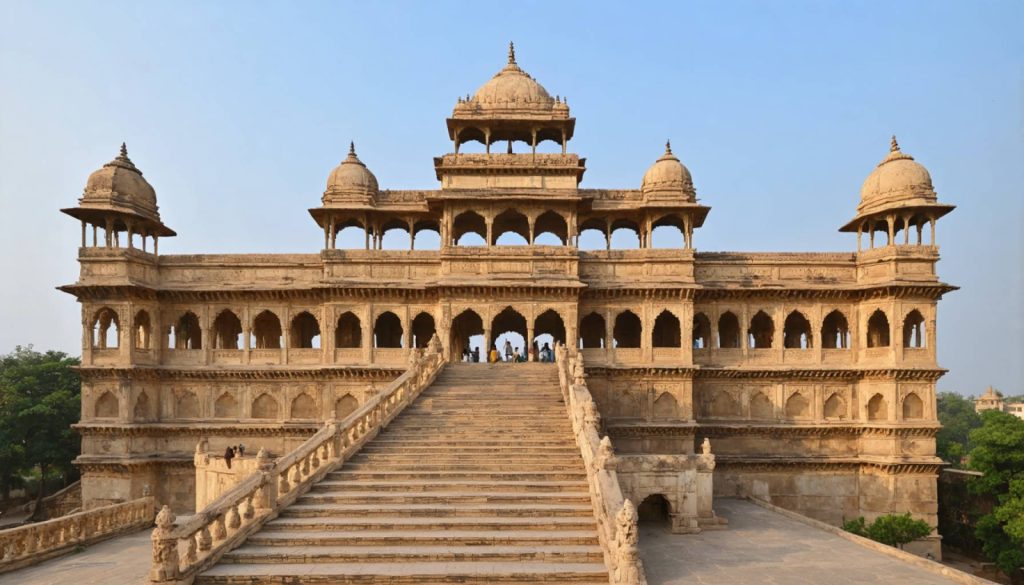
- India’s ancient architecture reveals the country’s rich cultural heritage through its diverse and intricate designs.
- The Amber Fort in Rajasthan showcases a blend of Hindu and Mughal architectural styles, with its famous Sheesh Mahal reflecting dazzling beauty.
- The Brihadeshwara Temple in Tamil Nadu, a UNESCO World Heritage site, exemplifies Chola dynasty engineering with its towering vimana.
- The Kailasa Temple at Ellora, carved from a single rock, demonstrates ancient India’s innovation and spiritual dedication.
- These structures are not just historical remnants but represent a continuity of creativity and vision still evident in India today.
- Visitors are invited to engage with India’s past, gaining insights into its enduring artistry and profound storytelling.
Embark on a journey through time as you explore the enchanting marvels of India’s ancient architecture. Each edifice tells a unique tale, reflecting the rich tapestry of the country’s cultural heritage. From the intricate carvings of temples to the grandeur of medieval forts, India’s architecture unfurls a canvas that captivates both the eyes and the soul.
Nestled in the heart of Rajasthan, the Amber Fort stands as a testament to the opulence of India’s past. Ascend its rugged stone pathways to marvel at the fusion of artistic Hindu elements and distinct Mughal architecture. The Sheesh Mahal, or the Mirror Palace, within the fort dazzles visitors, with thousands of mirrors reflecting light in a spectacle of dazzling beauty.
Further south, the Brihadeshwara Temple in Tamil Nadu emanates a different kind of wonder. This UNESCO World Heritage site, constructed over a thousand years ago under the reign of the Chola dynasty, showcases staggering engineering prowess and artistic mastery. Its towering vimana, or temple tower, soars nearly 70 meters into the sky, invoking a sense of spiritual grandeur.
Not to be overshadowed, the Kailasa Temple at Ellora is a marvel hewn from a single rock face. This monolithic structure leaves onlookers in awe of ancient India’s architectural innovation and dedication to spiritual expression. The intricate carvings and sheer size of the temple convey a powerful story of devotion and artistry.
While each site possesses its own distinct charm, they collectively highlight a continuity of vision and creativity that spans centuries. These ancient structures are not merely remnants of the past but are vibrant threads in the rich tapestry of India’s ongoing history. They serve as a reminder of the country’s ability to innovate and inspire, drawing visitors from around the globe to experience their wonder firsthand.
As you wander through these architectural wonders, the timeless beauty of India’s past beckons you to reflect and appreciate the creativity and spirituality that shaped this diverse nation. Through these majestic monuments, India proudly showcases its capacity for both enduring art and profound storytelling. Whether you are a historian, an adventurer, or an admirer of beauty, India’s ancient architecture promises an unforgettable journey into the past.
The takeaway from this journey? India’s ancient architecture invites you to glimpse the soul of a nation, eternally captured in stone. As you explore these wonders, let them inspire a deeper understanding and appreciation of the world’s shared cultural heritage.
Discover the Timeless Allure of India’s Ancient Architecture
India’s ancient architectural wonders remain a testament to its rich cultural heritage and intricate craftsmanship. While the Amber Fort, Brihadeshwara Temple, and Kailasa Temple are marvels in their own right, there is a myriad of other fascinating facts and insights that merit exploration.
Additional Facts & Context
1. Historical Influence and Cultural Exchange:
– The architectural styles of India reveal the impact of diverse cultures, including Persian, Greek, and Central Asian influences. The Mughal architecture seen in the Amber Fort, for example, is a direct result of Persian influences that accompanied Mughal rulers into India.
2. Engineering Marvels:
– The Brihadeshwara Temple was constructed without the use of modern machinery. The massive granite blocks were transported through a specially built inclined plane, displaying extraordinary ancient engineering techniques.
3. Mythology and Devotion:
– The Kailasa Temple at Ellora represents Mount Kailash, the sacred abode of Lord Shiva, demonstrating the integral relationship between spirituality and architecture in India.
How-To Steps & Tips for Exploring These Wonders
– Timing Your Visits: Early morning or late afternoon visits are recommended to avoid crowds and experience the temples during their most serene times.
– Guided Tours: Hiring knowledgeable local guides can provide an enriched experience, offering in-depth stories and historical context that might not be available in guidebooks.
Market Forecasts & Industry Trends
– With increasing global interest, India’s architectural sites are expected to see a rise in tourism. This influx propels preservation efforts and boosts local economies. According to the Ministry of Tourism, visitor numbers are anticipated to grow annually by 5-7%.
Reviews & Comparisons
– Amber Fort: Praised for its detailed artistry and impressive fusion architecture, the fort offers a glimpse into royal life and strategic military design.
– Brihadeshwara Temple: The temple’s scale and craftsmanship make it a favorite among architecture enthusiasts and historians.
– Kailasa Temple: Often ranked among the world’s most extraordinary man-made structures, its monolithic nature captivates all visitors.
Controversies & Limitations
– Preservation efforts face challenges due to environmental pollution and tourist footfall. Continuous efforts are underway to strike a balance between tourism and preservation.
Pros & Cons Overview
Pros:
– Unparalleled insight into India’s rich cultural history.
– Architectural diversity reflecting various dynasties and religions.
– Strong emphasis on preservation promotes sustainable tourism.
Cons:
– Overcrowding during peak seasons can detract from the experience.
– Accessibility might be limited for some sites, requiring extensive walking.
Quick Tips for Travelers
– Travel Insurance: Always purchase travel insurance when visiting sites, especially in remote areas, for peace of mind.
– Local Cuisine: Don’t miss the opportunity to try local cuisines near these sites to complete your cultural experience.
For further exploration of India’s vast history and heritage, visit the Incredible India official site for comprehensive guides and detailed information.
Embark on your journey with an open mind, ready to delve into the chapters of history etched in the stones of these timeless structures. Let this encounter inspire a profound appreciation for the world’s shared cultural heritage and a longing to preserve it for future generations.



